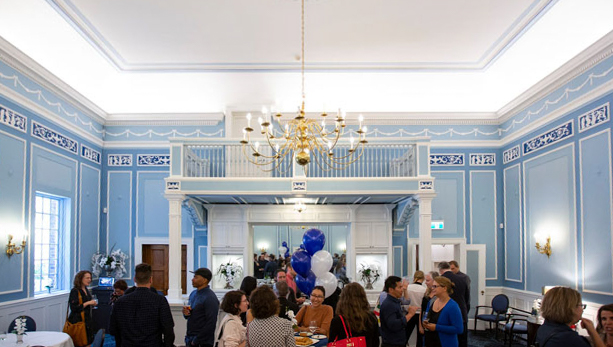Sparkling Wine – Joint Event with Toronto Vintners
 Although the story of the blind monk accidentally discovering sparkling wine is likely a myth, the heavenly experience of a quality sparkling wine is very real. To launch the holiday season in style, Toronto Vintners Club and Winetasters of Toronto have combined forces to offer their members a fabulous selection of sparkling wines from around the world. The beautiful Wedgewood room at the University of Toronto’s Faculty Club will be the setting for the first time that these distinguished wine clubs have held a joint event. There will be food stations, 5 champagnes, 6 sparkling wines from places that span the globe, an expert-led-tutored tasting and discussion, and plenty of time to interact with friends old and new. Sold already? Sign up here, or read on …
Although the story of the blind monk accidentally discovering sparkling wine is likely a myth, the heavenly experience of a quality sparkling wine is very real. To launch the holiday season in style, Toronto Vintners Club and Winetasters of Toronto have combined forces to offer their members a fabulous selection of sparkling wines from around the world. The beautiful Wedgewood room at the University of Toronto’s Faculty Club will be the setting for the first time that these distinguished wine clubs have held a joint event. There will be food stations, 5 champagnes, 6 sparkling wines from places that span the globe, an expert-led-tutored tasting and discussion, and plenty of time to interact with friends old and new. Sold already? Sign up here, or read on …
When one thinks of sparkling wine, champagne (which takes its name from the region of Champagne) is the first name that comes to mind but not all sparkling wine is champagne. Vintners around the world craft sparkling wines with products that offer a great diversity of styles, textures, and flavors. Like still wine, terroir is king, and both where the wine comes from and how the wine is made are two factors that distinguish one sparkling wine from another.
The grapes used to make the wine provide another distinguishing feature. In Champagne, you will commonly encounter wines based on Chardonnay, Pinot Noir, and Pinot Meunier, either solo or in various blends. But, there are actually seven permitted grape varietals that can be grown in Champagne. The other four are Pinot Gris, Pinot Blanc, Petit Meslier, and Arbane, all white varieties that make up less than 1% of all the region’s plantings. One of the champagnes we will be serving is made with all 7 grape varietals. Many countries follow Champagne’s lead, basing their wines on Chardonnay, and/or the two Pinots, while others use grapes local to their region. For example, in the Alt Penedes region of Spain, you will encounter sparkling wine, known as cava, made with Xarel Lo, Macabeu, and Parellada grapes. You will experience a premium example of this blend in this tasting.
Unlike most still wines, sparkling wine production often involves the addition of a small amount of sugar, known as the dosage, and added prior to the final closure of the bottle. The amount of the dosage is one of the factors that determine a wine’s perceived sweetness. The labels will tell you what you need to know: Nature and Extra Brut are the driest; Brut, the most common indicator, is dry; and Extra Dry or Dry are actually on the sweet side for the modern palate. Tastes have changed through the years. Most people now seek out drier sparkling wines and that is the style you will encounter when you attend this event. In fact, 5 wines will be Nature / Extra Brut, 5 Brut, and 1 Extra Dry.
The size and nature of the producer also result in significantly different wine styles. Historically, huge producers dominated the market globally. In Champagne in particular, small “grower producers” are becoming more prevalent. These producers typically take a more artisan approach to making wine often with stunning results. It’s probably fair to classify seven of the event’s wines as being artisan. Obviously, Toronto Vintners and Winetasters have a soft spot for artists.
Lastly, most sparkling wine is not vintage-specific. There are many reasons why producers blend two or more vintages together when they make sparkling wine. For example, the objective may be to achieve a consistent house style from year to year. In recent years, vintage sparkling wines are becoming more common. It’s also becoming common for
producers to provide information on the harvest years included in the blend. Smaller producers often do not have the capacity to store multiple years of wine and their offerings are vintage champagne in all but name.
We will kick off the evening with a reception wine and then a blind tasting of two wines discussed by our experts. After that, you will be free to explore eight sparkling wines in any order you like and experiment with pairing them with the food stations that will be set up around the room. To make this event more fun, Toronto Vintners and Winetasters members can bring a guest at member pricing. We look forward to a sparkling evening with you!
The full list of wines, and their details is here
When, Where & How
The tasting will take place at:
Faculty Club Wedgewood Room, Univ. of Toronto,
41 Willcocks Street, Toronto
Please do not drink and drive.
Calendar, Pricing & Sign-up Details
Date: Wed Nov 16
Time: 6:00 pm Registration, 6:30 event start
Cost: $150 members; $200 non-members –
Members may bring one (1) guest at member price.
Sign-up: here

Copyright © 2024 All Rights Reserved
